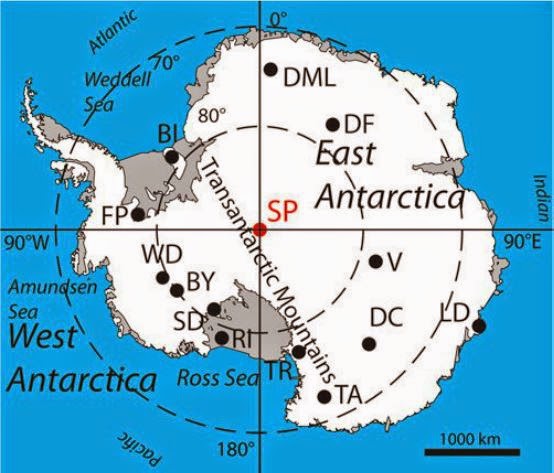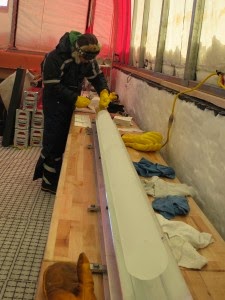
This winter, when many people’s imaginations were fixed on the North Pole, a small group of scientists has been working on the other side of the planet. In round-the-clock daylight and frigid temperatures, glaciologists have been drilling an ice core at the South Pole.
Drilling continues through the end of January for the first of two years of a joint project by the University of Washington and the University of California, Irvine. The National Science Foundation is funding the South Pole Ice Core Project to dig into climate history at the planet’s southernmost tip.
The 40,000-year record will be the first deep core from this region of Antarctica, and the first record longer than 3,000 years collected south of 82 degrees latitude.
“The cold temperatures in the ice, about -50 C, have caused some surprises with drilling since certain aspects of the drill perform differently even than during the test in Greenland at -30 C,” said T.J. Fudge, a UW postdoctoral researcher who is chief scientist for this month.
The location is just 2.7 km (1.7 miles) from the South Pole. Its thick, uncontaminated layers of ice will help answer questions about how Antarctic climate interacts with the rest of the world.

“South Pole is part of the East Antarctic Ice Sheet, yet is influenced by storms coming across the West Antarctic Ice Sheet,” Fudge said. “This core will help us figure out how the two sides of Antarctica communicate during climate changes in the past.”
The period between 40,000 years ago and 20,000 years ago includes sudden swings in temperature, and warming at the end of the last ice age.
Scientists were also attracted by cold conditions, even by polar standards.
“Most of the other places where we’ve worked the ice is -25 C to -30 C, and that’s too warm for rare organic molecules and other trace gases that people are interested in measuring,” said co-leader Eric Steig, a UW professor of Earth and space sciences.
“This is basically the coldest ice that we have drilled in,” said principal investigator Murat Aydin, a UC Irvine researcher who was chief scientist from setup of the field camp in early November through the end of December. “Everything is harder in the cold.”
All three scientists were part of a team that collected a more than 2-mile ice core from West Antarctica, a five-year effort that ended in 2011. Analysis of that ice is still ongoing at the UW, UC Irvine and many other labs around the country.
The new project at the South Pole is using a new intermediate-depth drill based on a Danish design, and a new drilling fluid. The team reached a depth of 1/2 kilometer (1/3 mile) on Jan. 14. Researchers hope to pass 700 meters by the end of this season and 1,500 meters (almost a mile down) by the end of next season.
“We’re not just trying to punch through the ice sheet, the most important objective is to bring up the highest-quality ice possible,” Aydin said.
After the core is drilled, three-foot sections will be flown to McMurdo Station and transferred to a ship. Scientists will then converge on Denver’s National Ice Core Laboratory this summer to process the samples and ship pieces to labs across the country.
In the UW’s IsoLab, Steig will analyze different types of oxygen molecules in the ice to determine the temperature. This will provide a record of climate changes for that region and help to evaluate the large-scale climate patterns across the Southern Hemisphere.
“The South Pole is one of the very few places in Antarctica that has not warmed up in the past 50 years,” Steig said. “That’s interesting, and needs to be better understood.”
The UC Irvine group will look at ultra-trace gases from air bubbles trapped in the ice. Aydin is interested in gases that are one in a billion to one in a trillion molecules in the atmosphere, but provide clues about the productivity of land-based plants and the extent of tropical wetlands during previous eras.
So far, looking at the core shows one layer of ash that the researchers think is tied to a volcanic eruption in the South Sandwich Islands.
“Otherwise, the core has been beautifully clear,” Fudge said.
Scientists work inside a field tent at about -20 C, the same temperature as the national ice core lab. Extra-curricular highlights of this year’s season included the Christmas Day round-the-world running race, and participating in the New Year’s annual marking of the South Pole.
Hear Fudge describe his work on a previous ice core:
Note : The above story is based on materials provided by University of Washington.










